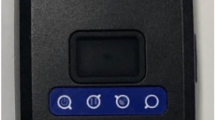Abstract
This article introduces the composition of the satellite navigation system, the working principle of the receiver, and the Beidou application system and then introduces the system architecture and functions of the wireless sensor network and summarizes the advantages and disadvantages of the two systems in practical applications. On this basis, a fusion system and wireless sensor network based on Beidou are designed. First, the application requirements and system characteristics are clarified, and then the overall architecture of the fusion system is proposed, and the workflow, software, and hardware components of the fusion system are described; then, the integrated system is applied in the actual environment. As a technical support is for the automatic monitoring of mountain debris flow and logistics and transportation. Based on the sedimentary characteristics of the S River study area, it is found that the valley morphology is consistent with the distribution analysis of highway flow, and it is found that there are two types of highway flow in the study area. Finally, this paper conducts a visual analysis of the relevant literature on the improvement of the electricity business environment from 2012 to 2020 in the CNKI database and discusses its current status, evolution, and hot spots in depth. Establish a comprehensive framework for improving the business environment of electricity. The research results show that the research of electricity business has new characteristics of the times. The research field always follows the policy orientation, focusing on simplifying the management and decentralization of electricity and economic development and improving the electricity business environment. Among them, the influencing factors and consequences of electricity business are the core themes of the research.
















Similar content being viewed by others
Change history
17 November 2021
This article has been retracted. Please see the Retraction Notice for more detail: https://doi.org/10.1007/s12517-021-08950-y
28 September 2021
An Editorial Expression of Concern to this paper has been published: https://doi.org/10.1007/s12517-021-08471-8
References
Adamala S, Raghuwanshi N, Mishra A (2014) Development of surface irrigation systems design and evaluation software (SIDES). Comput Electron Agric 100:100–109
Chari MM, Davari K, Ghahraman B, Ziaiei AN (2019) General equation for advance and recession of water in border irrigation. Irrig Drain 68:476–487
Chari MM, Poozan MT, Afrasiab P (2020) Modeling soil water infiltration variability using scaling. Biosyst Eng 196:56–66
Clemmens A, Bautista E (2009) Toward physically based estimation of surface irrigation infiltration. J Irrig Drain Eng 135(5):588–596
Duan R, Fedler CB, Borrelli J (2011) Field evaluation of infiltration models in lawn soils. Irrig Sci 29:379–389
Ebrahimian H, Liaghat A, Ghanbarian-Alavijeh B, Abbasi F (2010) Evaluation of various quick methods for estimating furrow and border infiltration parameters. Irrig Sci 28(6):479–488
Elliott RL, Walker WR (1982) Field evaluation of furrow infiltration and advance functions. Transaction of The ASAE 25(2):396–400
Ghorbani-Dashtaki S, Homaee M, Mahdian MH, Kouchakzadeh M (2009) Site-dependence performance of infiltration models. Water Resour Manag 23(13):2777–2790
Gillies M H (2008) Managing the effect of infiltration variability on the performance of surface irrigation. PHD dissertation. University of Queensland
Gillies MH, Smith RJ (2005) Infiltration parameters from surface irrigation advance and run-off data. Irrig Sci 24(1):25–35
Green WH, Ampt GA (1911) Studies on soil physics, 1. The flow of air and water through soils. J Agric Sci 4(1):1–24
Holtan HN. 1961 A concept of infiltration estimates in watershed engineering. ARS41–51, U.S. Department of Agricultural Service, WashingtonDC
Holzapfel EA, Jara J, Zuniga C, Marino MA, Paredes J, Billib M (2004) Infiltration parameters for furrow irrigation. Agric Water Manag 68:19–32
Horton RE (1941) An approach toward a physical interpretation of infiltration-capacity. Soil Sci Soc Am J 5(C):399–417
Isbell RF (1996) The Australian soil classification. CSIRO Publishing, Collingwood, p 143
James LG (1988) Principles of farm irrigation system design. John Wiley and Sons, New York, p 543
Kay M (1990) Recent developments for improving water management in surface irrigation and overhead irrigation. Agric Water Manag 17:7–23
Khatri KL, Smith RJ (2005) Evaluation of methods for determining infiltration parameters from irrigation advance data. Irrig Drain 54:467–482
Khatri KL, Smith RJ (2006) Real-time prediction of soil infiltration characteristics for the management of furrow irrigation. Irrig Sci 25(1):33–43
Kiefer F Jr (1965) Average depth of absorbed water in surface irrigation. Special Publication, \Logan
Kostiakov A N (1932) On the dynamics of the coefficient of water percolation in soils and the necessity of studying it from the dynamic point of view for the purposes of amelioration. Transaction of the Sixth Congress of International Society of Soil Science. Russian Part A, 17-21
Lewis MR, Milne WE (1938) Analysis of border irrigation. Agric Eng 19(6):267–272
McClymont DJ, Smith RJ (1996) Infiltration parameters from optimization on furrow irrigation advance data. Irrig Sci 17(1):15–22
Author information
Authors and Affiliations
Corresponding author
Ethics declarations
Conflict of interest
The authors declare that they have no competing interests.
Additional information
Responsible Editor: Sheldon Williamson
This article is part of the Topical Collection on Environment and Low Carbon Transportation.
This article has been retracted. Please see the retraction notice for more detail:https://doi.org/10.1007/s12517-021-08950-y
About this article
Cite this article
Zhou, X., Han, S., Liang, Z. et al. RETRACTED ARTICLE:Wireless sensor-based prediction of debris flow in mountainous areas and improvement of power business environment. Arab J Geosci 14, 1493 (2021). https://doi.org/10.1007/s12517-021-07754-4
Received:
Accepted:
Published:
DOI: https://doi.org/10.1007/s12517-021-07754-4




